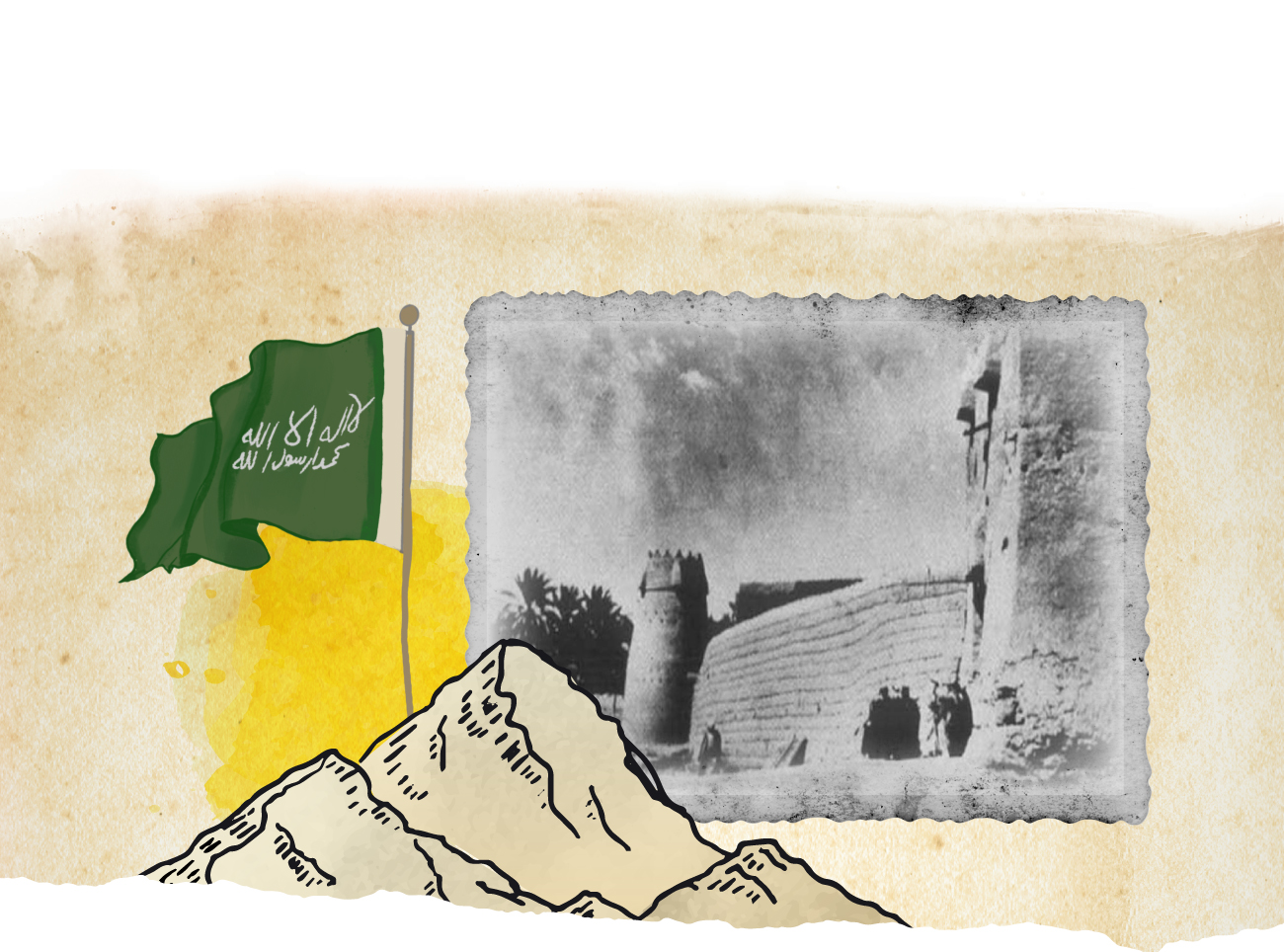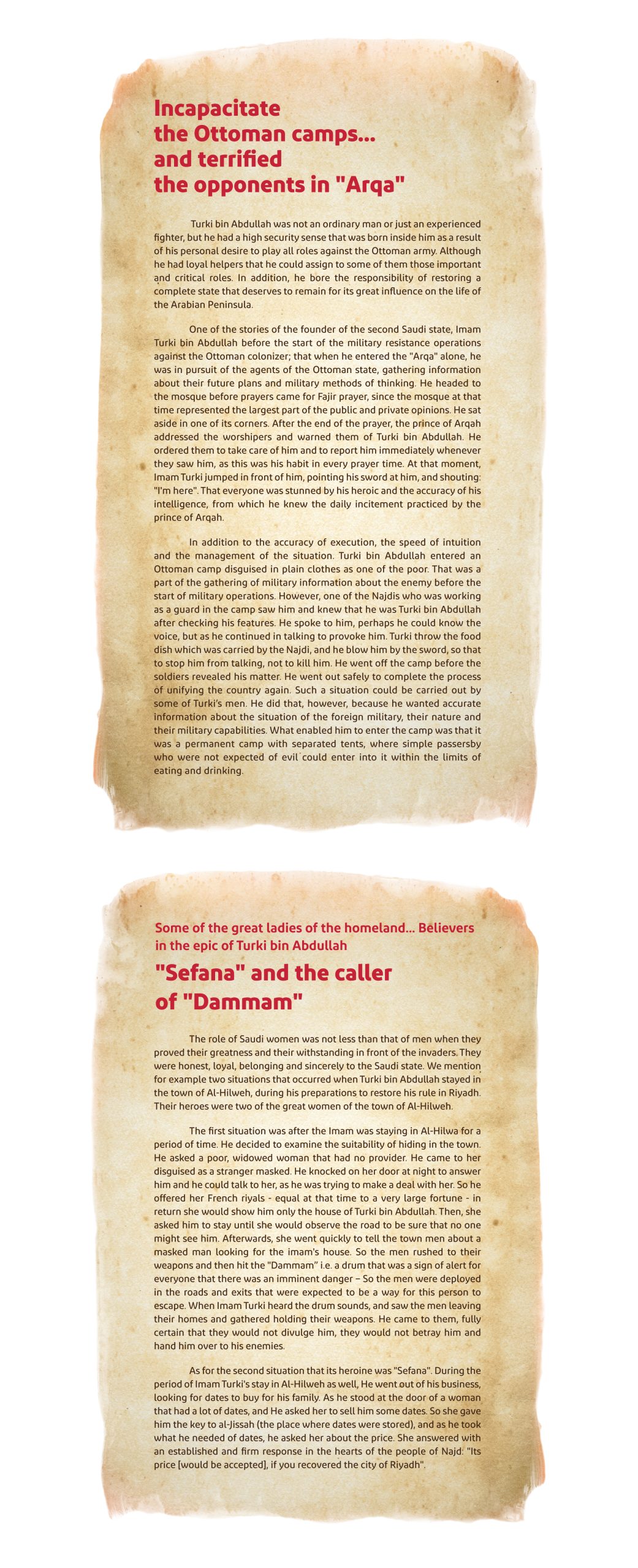
The Imam who Was Loved By Lands ... Turki Bin Abdullah
He left Diriyah at night ... so as he would bring back “Daylight” of homeland seven years later
Diriyah was turned into a ghost town, where dust and terrified sounds were prowling together with the smell of gunpowder and the tremors of Ottoman cannons, which overcame ears to hear the call of Athan and Saudis’ prayers [to Allah] to reveal the affliction. That was after the first Saudi capital was a city that achieved a discrete level Economically, physically and securely, so that it reached the level of food self-sufficiency. As a result, many Arab workers and merchants lived in it in secure and stability.
In two contradictory situations, one of the most encouraging Saudis came out inspired by the values of his noble family and great forefathers; on the other hand, he was inspiring his children and grandchildren with dignity and courage. After he blew up the Saudi national identity in their souls. Imam Turki bin Abdullah bin Mohammed bin Saud was full of his homeland and his citizens. At the time in which Diriyah was screaming under the barbaric pressure of the Ottoman army, its brutality and insatiable to blood, killing and torture. After Istanbul saw the first Saudi state was gaining national and spiritual unity between the Saudi people and their imams, that jeopardized their Turkish state.
He carried his soul on his hands for the sake of the homeland.

After the fall of Diriyah
Turki bin Abdullah was one of the brave defenders during the siege of Ibrahim Pasha to Diriyah. When he was entrusted by the last imams of the first Saudi state, Abdullah Bin Saud, to protect the southern side of Diriyah, accompanied by his brother Zaid and a group of the people of Diriyah. Since Diriyah was conquered by Ottomans and Turki was among those who were wanted on the list of the Ottoman leader, he decided to tactically withdraw from Diriyah in order to return for resisting the occupation and conquering the invaders. Because he was aware that they would not last long, and considering that they came to ruin only.
In (1818), Turki went to the Shamir family in the desert of Ajman where he stayed with them for a while, during which he married the daughter of their leader Ghaidan bin Jazaa and had his son Jalawi who was named by that name after his (Jalouteh, i. e. deporting) from Diriyah. He spent a lot of time on movements among Najd cities in order to support his strength and increase his followers. As he established his headquarters on Mount Aliya, after he stayed for a period of time in the town of Al-Hilweh, south of Najd city, near Hotat Tamim city.
“Aliya” is an overlooking mountain and a plateau of the Yamama Mountains. It is an impenetrable and high mountain. The selection of this distinctive geographic location reflected the far-sightedness of leadership of the Imam. As it is overlooking to several sides: Al-Kharj and Wadi Nassah in the south, Wadi Naam, Al-Hariq and a part of the town of Al-Houta in the north, and the valleys of Juffair, Murqan, Majoulah, and Huneiza in the west. “Aliyah” mountain was mentioned in the poetry of Imam Turki bin Abdullah, as he said:

Imam Turki tried to utilize secrecy in his movements as an important strategy. As he was keen on frequent movements amongst towns and valleys. So that he would not be easily tracked like when he stayed in one place. As signs of rehabilitation to Diriyah appeared again, and the unity to be re-established once again by the solidarity of the people around Mashary Bin Saud Bin Abdul Aziz, the son of Imam Saud. Who was captured by Ibrahim’s army, yet he managed to flee from the Ottoman camp before reaching Yanbu coming from Medina. He reached Najd accompanied by his guardians. The people gathered around him until he reached Diriyah in (1820). He was joined and supported by Imam Turki Bin Abdullah, when he was returning from his headquarters in “Aliyah” mountain; further, Mashary appointed him as a governor of Riyadh.
However, the Ottoman garrison at Unaizah city was planning to end the movement of Mashari. He was arrested and taken to the Ottoman garrison, where he died in the prison of garrison. The Imam Turki returned to withdraw strategically for resisting the Turks again. He conducted his previous method of moving. (Dhurma) was one of the Najdi cities in which he was staying with his followers. The Ottomans’ intelligence knew that he was there when a garrison of 100 collaborators was sent to Dhurma. Before that, a messenger was sent to inform their followers in the town of their arrival in order to arrest the imam and his soldiers.
Imam Turki was observing the roads, expecting that the enemy has no way to him except through the trick. He found the messenger before he reached Dhurma, arrested him and was informed of the plans of collaborators with the Ottoman garrison. Moreover, he knew the house from which his enemies led the movement in the town. He hurried back to his followers and ordered them to resort to a palace, while he went out at night before implementing the plan directed against him. He headed to the house, where he was waiting with others for those who would come to him. He entered into the house to them while they were sitting around the fire. He started to fighting them with his sword after they put out their fire for fear of death with the sword of Turki. They escaped and surrounded the house, wounded and afraid. As a result of what they saw of the Imam’s courage and his entrance to them alone, they declared their joining to him. While he encountered the expedition that was sent to him and defeated them before achieving any results they were planning to. Instead, the results were counterproductive to increase the supporters of Turki bin Abdullah.
Turki leads the homeland
The conditions were appropriate after the victory of Turki bin Abdullah in Dhurma. So he decided to seize the opportunity and headed towards Diriyah to end the control of the Turkish loyalists. Indeed, he managed to do so, and then he went to Riyadh, where he established his headquarters. However, the garrison of Abbosh Agha in Unaizah city was joined by a new military force coming from Medina under the leadership of Hussein Bey. That force was convinced of the need to move towards Imam Turki in Riyadh and get rid of him before he would get stronger. The military expedition arrived, besieged him and his followers. Because of the length of the period of siege and for fear of decreasing supplies of the besieged followers, the imam decided to withdraw again from Riyadh with the intention to return back stronger than he was, after he surrendered. Especially when no one remained in the Saudi domain, at that time, who was Qualified for that. Unlike Imam Turki that had the courage that people hear about and the advantage that made him triumph over his enemies through horror before confrontation. As he possessed the leadership qualities from his predecessors in the first Saudi state. So it is necessary to him not to surrender to the forces of Hussein Bey and Abbosh Agha, in order to complete the dignity of the homeland and restoring its unity.
The imam was fully aware that these garrisons and leaderships that came from time to time and that they would not stay for a long, given that the Saudi society could not accept them. As they came with the intent of destruction, pillage and plunder. Over time, they would be forced to retreat and withdraw. Indeed, by the end of the year (1821), Abbosh Agha and Hussein withdrew. Some Ottoman garrisons remained in a number of important Najdi cities, which were concerned by Ottomans that they would be reunited.
He dislodged the Ottoman criminals in a great nobility.

Therefore, at the beginning of the year (1822), the Ottomans sent a military expedition led by Hussein Abu Zahir. While the tribes and the Najdi cities declared their loyalty to Turki and supported him in rebuilding the Saudi state again. Thus, the imam led them from time to time against the Ottoman garrisons, especially against the garrisons of Riyadh and Manfuha.
Abu Zahir tried to send punitive expeditions to the tribes that had declared their allegiance to the imam, but most of them were defeated and their leaders were killed. Many other Najdi cities also withstood on their face and confronted his forces. So not so long later, Abu Zahir decided to leave again from Najd, leaving behind him weak and dilapidated garrisons that were unable to confront the homeland that withstood against the brutality, oppression, elimination and crimes.
Saudis scored a victory
None of the forces of the invaders remained to fight in front of Imam Turki except for the two garrisons of Riyadh and Manfuha in (1823). So the Imam resumed his resistance to them after he came from the town of Al-Hilweh, and he headed to Arqa, close to Riyadh. Those who pledged allegiance to him joined him from a number of Najdi cities that announced their accession under his leadership. During that period Turki bin Abdullah was a name that shook the Turks on the ground of the headquarters of both garrisons. At the same time, people were impressed by the championships of the Imam, his bravery, and his strength.
Imam Turki faced the forces of the garrison of Riyadh in Arqa. He was fighting them in a guerrilla manner that exhausted them and led them to declare their helplessness in front of him. They were constantly concerned about the possibility of attack at all times. Especially the communication was cut between the two garrisons and their direct headquarters in Medina. After about 20 days during which the garrison in Manfuha city was besieged, the garrison was forced to leave the town after taking a promise of safety to leave.
In (1825), Imam Turki tightened his siege on the Riyadh garrison. After fierce clashes between him and the garrison forces, in addition to a siege that lasted for months. Then the besieged garrison realized that they should surrender. The victory they aspired to was their departure without a massacre to be conducted to them. The forces of that garrison were the last force of the Ottoman forces that were left in the country, after which Imam Turki declared his imamate in his new capital, Riyadh. In which the second Saudi state was established in (1825).
Letting Saudi history to be written during the second state in an epic in which the Turks were defeated and humiliated, and proved that the lands accept only its leaders those whose love was rooted in people’s hearts. At a time when society proved its dedication and cohesion with its leadership. So that the Saudis remain as a thorn in the Ottoman throat, that tore their history on their lands, including their forces, their equipment and their stubbornness. The Saudis were the force that brought the Turks and their tyranny to their knees, and broke the base of tyranny and arrogance.
He established the national identity.. and freed “geography” from being drowned into oblivion.




- Othman bin Bishr, Address of glory in the history of Najd, edited and commented by: Abdulrahman Al Sheikh, 4th Edition (Riyadh: Department of King Abdulaziz, 1983).
- Munir al-Ajlani, Imam Turki bin Abdullah Batal of Najd and its liberator (Riyadh: Al-Shibl House, 1990).
- Abdel Fattah Abu Aliya, History of the Second Saudi State, 5th Edition (Riyadh: Al-Merrikh House, 1995).
- Khalifa Al Masoud, the position of the opposing forces from the second Saudi state (Riyadh: Department of King Abdulaziz, 2005).

